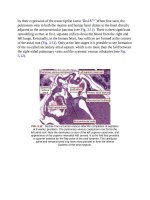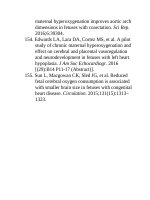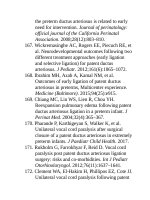Andersons pediatric cardiology 1860
Bạn đang xem bản rút gọn của tài liệu. Xem và tải ngay bản đầy đủ của tài liệu tại đây (62.01 KB, 3 trang )
unittoconfirmplans,havenecessaryequipmentavailable,andprovideclosedloopcommunication.
InvasiveandNoninvasiveMonitoring
ThemonitoringconsiderationsforthepostoperativeSCPCpatientaresimilarto
thosedescribedfollowinginitialpalliation.Onceagain,thegoalofmonitoringis
theearlydetectionofanevolvingimbalanceinDO2andVO2.Inaddition,as
pleuraleffusionsarecommonfollowingtheSCPC,trendsinthenoninvasive
continuousmonitoringofrespiratoryrate,heartrate,andpulseoximetrymaybe
thefirstsignsofadevelopingeffusion.
PostoperativeManagementFollowingthe
SuperiorCavopulmonaryConnection
WithtransitionfromamultidistributioncirculationtotheSCPC,thevolume
load,COrequirement,andmyocardialVO2arereduced.Theacutedecreasein
ventricularvolumecreatesamismatchbetweentheventricularvolumeand
musclemass,causingdiastolicdysfunction(seeFig.71.3).Qpisprimarily
determinedbythevolumeofbrachiocephalicoutflow,cerebralmetabolism,and
thepressuredevelopedwithinthecerebralvenouscirculationandsuperiorcaval
vein(seealsoChapter70,Fig.70.4).Cerebralbloodflow/DO2istightlycoupled
tometabolismandremainsconstantwithchangesinsystemicarterialblood
pressureaslongasthepressureoscillateswithintherangeofpressure
autoregulation.Uncouplingofcerebralbloodflowfrommetabolismincreases
cerebralDO2andthereforeQp,asoccurswithpermissivehypercapnia.
ArterialhypoxemiafollowingtheSCPCmaybeduetopulmonaryvenous
admixtureresultingfromalveolardiseaseorarteriovenousmalformations
(AVMs).HypoxemiamaybeduetoadecreaseinQp,whichmayresultfroman
obstructiontoflowatthesuperiorvenacava–pulmonaryarteryanastomosisor
fromanincreaseinPVR,butonlyinthepresenceofdecompressingvenovenous
collaterals.Intheabsenceofvenovenouscollaterals,cerebralvenousreturnwill
beobligateintothepulmonaryvascularbed,resultinginanincreaseinSVC
pressure.Overtime,whichisvariablefrompatienttopatient,elevatedSVC
pressuremayleadtotheformationofdecompressivevenovenouscollaterals
betweenthesuperiorvenacavaandinferiorvenacavasystemorrightatrium.
(SeeChapter70foramorecompletedescriptionoftheseanatomicconnections.)
Inadditiontocausingarterialhypoxemia,adecreaseinQpwillincreasethe
arterial-to-endtidalCO2gradient.Contrastechocardiography(agitatedsaline
injectedintoanupperextremityvenouscatheter)willestablishthediagnosisof
pulmonaryAVMsandvenovenouscollateralsthatmaybepresentintheanterior
venouscompartment.Posteriorvenovenouscollateralsthroughthenonvalved
cerebrospinalcirculationandBatsonplexuswillnotbevisiblewithsaline
contrastechocardiographyandmaybevisibleonlybyMRIofthevenous
drainageofthehead.
Treatmentstrategiesforimprovingoxygenationcanvaryconsiderablyand
dependontheunderlyingmechanisms.Inadequatelungvolumerespondsto
positiveairwaypressure;but,asdiscussedpreviously,PPVmayhaveanadverse
effectonsystemicvenousreturnandselectivecerebralvenousreturnthrough
anteriorandposteriorvenoussystemsaswellasPVR.
AnincreaseinITPdecreasestheeffectivecomplianceoftheSVC–pulmonary
arteryconfluence,increasingthepressurewithin,whichrepresentsthe
downstreampressureforsystemicvenousreturnfromtheheadandneckvessels.
Ariseinthedownstreampressuremustbecompensatedforbyanincreasein
cerebralvenous/SVCpressureorQpwillfall.Conversely,minimizingITPor
transitioningtospontaneousventilationincreasesthepressuregradientfor
systemicvenousreturn,loweringvenouspressure,decreasingflowthrough
venovenouscollaterals,andincreasingQp.Intheeventthatthetranspulmonary
vascularpressureiselevated(>5to10mmHg,SVCpressure–commonatrial
pressure),considerationshouldbegiventotheuseofpulmonaryvasodilators
suchasinhalednitricoxideandevaluationforanatomicsubstratesfor
obstructiontoflowsuchasnarrowingatthecavopulmonaryanastomosis
(requiringaninterventionalcatheterization).AnothermeasuretoincreaseQpis
theuncouplingofcerebralbloodflowfromcerebralmetabolismwithpermissive
hypercapnia.HypercapniaandacidosisalsoincreasePVR;however,studies
havedemonstratedthattheneteffectisanincreaseinQp.231Thisstrategy
requirestheuseofmusclerelaxantsandtherealizationthattheeffectwanesover
hoursduetonormalizationofthepHintheperivascularspaceoftheblood-brain
barrier.
CommonPostoperativeFindings
Systemichypertensionisobservedinthemajorityofinfantswhoundergoan
SCPC.Althoughtheexactetiologyofhypertensionisunknown,themostlikely
etiologyisanincreaseinsystemicbloodpressuretomaintaincerebralperfusion
whenthereisanincreasewithcerebralvenouspressure.Othermechanisms
includeanincreaseincatecholaminesrelatedtopainandincreasesin
neurohormonesincludingangiotensinIIandaldosterone.232,233Unlessthereis
mediastinalbleeding,aggressivetreatmentofhypertensionearlyaftertheSCPC
isgenerallyavoided,asitmayreducecerebralbloodflow,whichwillthenlead
toreducedpulmonarybloodflowandhypoxemia.FollowingtheSCPC,many
infantsareroutinelytreatedwithmilrinonefollowingandinsome(e.g.,those
whoarebleedingorhaveotherreasonstoavoidsystemichypertension,suchas
importantAVvalveregurgitation),hypertensionmayalsobetreatedwithsodium
nitroprusside;thisstrategyhasbeenshowntodecreasesystemicbloodpressure
withoutchangingcerebralbloodfloworsystemicoxygencontentfollowingthe
SCPC.232
Manyinfantsarequiteirritablefor2to4daysfollowingtheSCPC,which
appearstobetemporallyrelatedtothecommonfindingofupperextremity
edemaandplethora,producingtheappearanceof“SVCsyndrome.”Theraised
intracranialpressureassociatedwiththeelevationinvenouspressureinthe
upperbodycancauseheadacheandcoughinolderpatients,andthisislikelyto
bepresentininfantsaswell.234,235Judicioususeofpharmacologicanalgesics
andtheextensiveuseofnonpharmacologicmeasurearetypicallysufficient
duringtheseearlydaysaftersurgery.
SinusNodeDysfunction/Arrhythmia
Earlypostoperativearrhythmiasareinfrequentunlesstherearesecondary
interventionsontheatrialseptumorAVvalveatthetimeofsurgery.When
arrhythmiasoccur,theyaremostcommonlyatrialinorigin.Externalpacing
maneuversorpharmacologicstrategiesshouldbeusedtoprovidearteriovenous
synchronyintheearlypostoperativeperiod.Latepostoperativerhythm
abnormalitiesaremostcommoninpatientswithtricuspidatresia,withthe
majorityhavingatrialtachycardiaorsinusnodedysfunction.
PleuralEffusionsandChylothorax
Chylothorax,requiringchesttubesforlongerthan1week,canoccurinupto
15%ofpatientsfollowingaSCPC.236Thelymphaticvesselscoalescetoform









